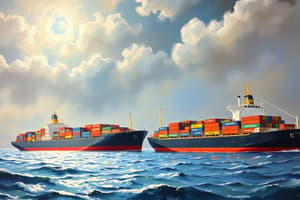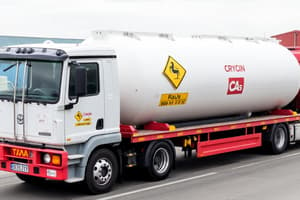Podcast
Questions and Answers
What is the first step in the general mechanism of bulk transport?
What is the first step in the general mechanism of bulk transport?
- Tethering
- Budding (correct)
- Fusion
- Uncoating
During which step of bulk transport does the coat proteins get removed?
During which step of bulk transport does the coat proteins get removed?
- Uncoating (correct)
- Scission
- Fusion
- Translocation
What acronym can be used to remember the six steps of bulk transport?
What acronym can be used to remember the six steps of bulk transport?
- Bu-Sci-Un-Tra-Te-Fu (correct)
- Bu-Te-Sci-Fu-Un-Tra
- Bu-Sci-Tra-Un-Fu-Re
- Bu-On-Tra-En-Re
Which step follows the uncoating process in bulk transport?
Which step follows the uncoating process in bulk transport?
What occurs during the fusion step of bulk transport?
What occurs during the fusion step of bulk transport?
Which of the following steps involves the vesicle moving closer to the target membrane?
Which of the following steps involves the vesicle moving closer to the target membrane?
How many steps are involved in the general mechanism of bulk transport?
How many steps are involved in the general mechanism of bulk transport?
What is the main purpose of the targeting step in bulk transport?
What is the main purpose of the targeting step in bulk transport?
What is the primary function of vesicles in bulk or vesicular transport?
What is the primary function of vesicles in bulk or vesicular transport?
Which organelle is primarily responsible for producing vesicles used in transport?
Which organelle is primarily responsible for producing vesicles used in transport?
What is the first step mentioned in the general mechanism of bulk transport?
What is the first step mentioned in the general mechanism of bulk transport?
What role do coat proteins play in bulk transport?
What role do coat proteins play in bulk transport?
Which process contributes to the formation of vesicles during bulk transport?
Which process contributes to the formation of vesicles during bulk transport?
What is the purpose of the scission proteins in the context of vesicular transport?
What is the purpose of the scission proteins in the context of vesicular transport?
In the bulk transport mechanism, what happens during the uncoating stage?
In the bulk transport mechanism, what happens during the uncoating stage?
Which statement distinguishes bulk or vesicular transport from other transport mechanisms?
Which statement distinguishes bulk or vesicular transport from other transport mechanisms?
What process is involved when white blood cells release antibodies as an immune response?
What process is involved when white blood cells release antibodies as an immune response?
Which type of vesicular transport involves the engulfing of solid particles by cells?
Which type of vesicular transport involves the engulfing of solid particles by cells?
What is the primary function of pinocytosis?
What is the primary function of pinocytosis?
Which mechanism is involved in the uptake of large molecules by a cell through receptor binding?
Which mechanism is involved in the uptake of large molecules by a cell through receptor binding?
During which process do cells take in nutrients through a membrane extension?
During which process do cells take in nutrients through a membrane extension?
Which of the following describes the action of exocytosis?
Which of the following describes the action of exocytosis?
What common characteristic is shared by all types of vesicular transport?
What common characteristic is shared by all types of vesicular transport?
Which type of bulk transport would most likely be responsible for a cell taking in ions or small molecules?
Which type of bulk transport would most likely be responsible for a cell taking in ions or small molecules?
Which molecules can be transported through bulk transport?
Which molecules can be transported through bulk transport?
Which process involves the engulfing of solid molecules by a cell?
Which process involves the engulfing of solid molecules by a cell?
What distinguishes receptor-mediated endocytosis from regular endocytosis?
What distinguishes receptor-mediated endocytosis from regular endocytosis?
What role do synaptic vesicles play in neurotransmission?
What role do synaptic vesicles play in neurotransmission?
What is the primary difference between phagocytosis and pinocytosis?
What is the primary difference between phagocytosis and pinocytosis?
Which process involves the formation of vesicles around a liquid?
Which process involves the formation of vesicles around a liquid?
What is the role of the coated pit in receptor-mediated endocytosis?
What is the role of the coated pit in receptor-mediated endocytosis?
Flashcards
What are large molecules called?
What are large molecules called?
Substances such as proteins, carbohydrates, and lipids that are too large to pass through the cell membrane by simple diffusion or active transport.
What is a vesicle?
What is a vesicle?
A small, membrane-bound sac that transports materials within and out of the cell.
What is bulk transport?
What is bulk transport?
The process by which large molecules are transported into or out of the cell using vesicles.
What is budding?
What is budding?
Signup and view all the flashcards
What is fusion?
What is fusion?
Signup and view all the flashcards
What is the role of coat proteins in bulk transport?
What is the role of coat proteins in bulk transport?
Signup and view all the flashcards
What is uncoating?
What is uncoating?
Signup and view all the flashcards
What is translocation?
What is translocation?
Signup and view all the flashcards
Budding
Budding
Signup and view all the flashcards
Scission
Scission
Signup and view all the flashcards
Uncoating
Uncoating
Signup and view all the flashcards
Translocation
Translocation
Signup and view all the flashcards
Tethering
Tethering
Signup and view all the flashcards
Fusion
Fusion
Signup and view all the flashcards
What does "BSUTTF" stand for?
What does "BSUTTF" stand for?
Signup and view all the flashcards
How do different vesicular transport types differ?
How do different vesicular transport types differ?
Signup and view all the flashcards
Vesicular Transport
Vesicular Transport
Signup and view all the flashcards
Exocytosis
Exocytosis
Signup and view all the flashcards
Phagocytosis
Phagocytosis
Signup and view all the flashcards
Pinocytosis
Pinocytosis
Signup and view all the flashcards
Receptor-mediated endocytosis
Receptor-mediated endocytosis
Signup and view all the flashcards
How nucleic acids leave the cell through exocytosis.
How nucleic acids leave the cell through exocytosis.
Signup and view all the flashcards
How electrolytes enter the cell through endocytosis.
How electrolytes enter the cell through endocytosis.
Signup and view all the flashcards
How a pathogen is recognized by white blood cells through phagocytosis
How a pathogen is recognized by white blood cells through phagocytosis
Signup and view all the flashcards
Bulk Transport
Bulk Transport
Signup and view all the flashcards
Study Notes
Bulk or Vesicular Transport
- Bulk transport is how large molecules, unable to be carried by transport proteins, move into and out of a cell.
- Eggs, milk, and meat are rich sources of proteins which aid in muscle, immune system, bone development and metabolism.
- Proteins are essential macromolecules for crucial cellular functions.
- Proteins and other large molecules are transported via bulk or vesicular transport.
- Bulk transport involves multiple steps: budding, scission, uncoating, translocation, tethering, and fusion.
- The processes can be remembered using the acronym BSUTTF.
- Vesicles are structures within or outside the cell, containing cytoplasm enclosed by a lipid bilayer.
- Vesicles are created during processes of secretion, uptake and transport of molecules.
- Golgi bodies frequently produce vesicles that transport cell products to the cell membrane.
- The general mechanism of Bulk transport includes a series of steps: budding, scission, uncoating, translocation, tethering, and fusion.
- Coat proteins bind to sorting signals.
- Molecules are transported using a vesicle around a liquid molecule during pinocytosis.
- Phagocytosis involves the cell engulfing molecules through extensions.
- Exocytosis releases molecules outside the cell and endocytosis transports molecules into the cell.
- Cell transport types include exocytosis, phagocytosis, pinocytosis and receptor-mediated endocytosis.
Studying That Suits You
Use AI to generate personalized quizzes and flashcards to suit your learning preferences.




